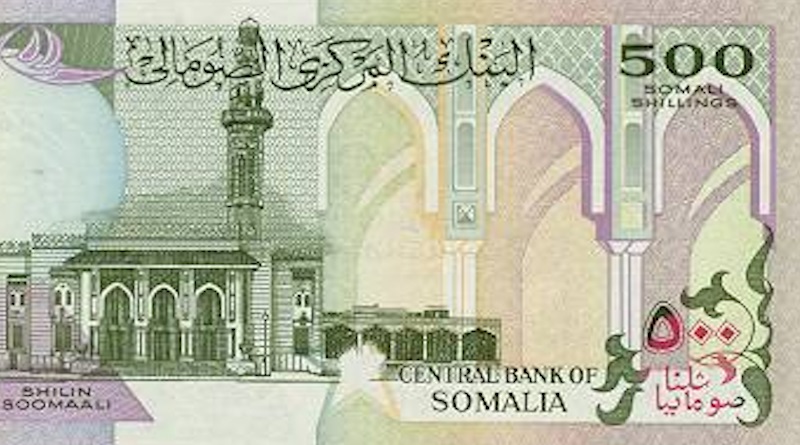
February 20, 2023 | Eurasia | By Abdiwahab Hussein Mohamed – Somalia, a country that has been ravaged by conflict and political instability for more than three decades, has recently announced plans to issue new banknotes to tackle the problem of inflation and stabilize the economy. The move is expected to address the unusual situation in Somalia’s currency market, where both legitimate and counterfeit notes are accepted interchangeably despite the fact that it is easy to distinguish between the two.
The Somali shilling operates in a unique manner without the support of a central bank, as the civil war that erupted in 1991 left Somalia without a functioning Central Bank and national government. Despite the absence of a regulatory framework, the Somali shilling banknotes have remained in circulation, a testament to the resilience of the Somali people who continue to utilize the currency in their daily transactions. This phenomenon has challenged traditional monetary policies and prompted experts to explore alternative currency systems, leading to a new understanding of monetary policy and financial regulation.
Adding to the peculiarity of the situation in Somalia is the rampant counterfeiting of banknotes, flooding the market and driving down the exchange value of the Somali shilling. What’s even more surprising is that Somalis have found a way to turn this problem into a lucrative business by contracting with foreign printers to import even more counterfeit notes.
Despite the decrease in the shilling’s value from $0.30 in 1991 to a mere $0.03 today, the influx of fake currency has actually stabilized the currency’s purchasing power through the introduction of additional banknotes. This unique phenomenon of counterfeiting leading to financial stability is a paradoxical marvel, but it raises ethical questions about the legality and morality of profiting from illegal activities.
To address the issue, the Central Bank of Somalia (CBS) has announced its intention to introduce new banknotes in mid-2024. This move could effectively address several long-standing issues that have plagued the country’s economy, including high rates of inflation, the circulation of counterfeit currency, and the use of cash for terrorism. Currency reform is an indispensable component of Somalia’s economic recovery. Since 1991, the CBS has not issued any notes, relinquishing control over the exchange rate and money supply. The bulk of transactions in Somalia, whether via cash or mobile money transfers, are made in US dollars or counterfeit Somali shillings. Currently, 95% of the Somali shilling in circulation is counterfeit and widely accepted as a means of payment, despite being unmistakably fake. Regrettably, an influx of new counterfeit notes has played a pivotal role in the depreciation of the shilling.
However, the success of this move is uncertain, as other countries that underwent rapid demonetization experienced negative consequences, including riots, deaths, and significant economic downturns in Zimbabwe, Ghana, and Myanmar.
The journey towards weaning Somalis off the ubiquitous US dollar is a daunting task, even with the development of a currency reform plan. The process of de-dollarisation presents complex logistical challenges, and reintroducing the Central Bank of Somalia printed notes will put the trust of the Somali people in the federal government to the ultimate test. It’s worth noting that for over two decades, Somalia has been operating essentially as a failed state, and the reintroduction of national currency comes with significant political implications.
The involvement of the International Monetary Fund may add some measure of credibility to the process, but the fight against the pervasive counterfeit currency market presents an even greater challenge. This is because the dismantling of corrupt networks will require navigating complex political terrain that is highly susceptible to manipulation.
In the face of all these daunting challenges, however, we must remain hopeful that Somalia can overcome the obstacles and achieve its goal of a stable, self-sufficient economy. It will take a concerted effort from all stakeholders, including the government, civil society organizations, and the Somali people themselves, to make the currency reform plan a success. Ultimately, the process of transitioning away from the dollar and rebuilding trust in the Somali shilling will require patience, resilience, and sustained commitment from all involved.
In the midst of persistent economic instability and uncertainty in Somalia, the efficacy of the central bank’s proposed banknote policy in curbing inflation and ushering in a new era of stability in the country’s currency market remains to be seen; as the events unfold, it is crucial to monitor the policy’s impact and its potential to chart a new path for Somalia’s economic progress.
___________________________________________________________________
Abdiwahab Hussein Mohamed holds an M.A. in Economics with a sharp focus on macroeconomics and monetary policy. Passionate about the impact of economic policies on society, he is committed to driving sound decision-making in this field.
.
.
Xafiiska Wararka Qaranimo Online | Toronto
_____________________________________________________________
_____________________________________________________________________________________Xafiiska Wararka Qaranimo Online | Mogadishu, Somalia
_____________________________________________________________________________________Advertisement
_____________________________________________________________________________________







